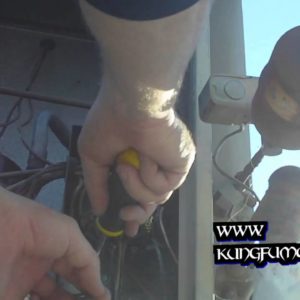We've got an AC not working. I actually already
replaced the fuses and checked it out. We've got power here, but it's not working. The
compressor's not hot, and the top of the fan motor's not hot, so that leads me to look
at the contactor. Looking at the contactor the contactor is just fine. It's like brand
new. I think it's actually our capacitor, so I'm going to change that out. This is a
dual cap, so it's pretty simple to change out. I'm going to go ahead and pull my disconnect
right here. I've got the brand new fuses in there.
I'm going to go ahead and discharge
the capacitor. Now when I check the voltage with my circuit alert device, we can change
the capacitor safely. I'll go grab that. OK, so I'm changing out the dual cap here.
I've got my new one. You always want to make sure it's the same microfarad. This is a 35.5
microfarad. So we're going to connect herm, common and fan just the way it is here. We've
got to loosen the holder here, and then slip each of the leads off. This yellow one is
for the herm, or hermetic. It's not a bad idea to replace the hard start kit at the
same time, but this one looks pretty new. There we go, herm. Make sure our leads are
all nice and tight. Here's our fan wire. Let's get our fan going. Again, make sure that's
nice and tight if not we can tighten these up. When it's fairly tight then I'm going
to squeeze that down just a tiny bit on those two. That's good.
We're ready to go. There's another way to wire this. You could
do a single cap, a 35, and then do a single 5, put one wire to one side of the 5 and then
a jumper wire going over, but that's another story. I'll save that for another video. I'll
show you that sometime if not today. Tuck this back here nice and secure.
Then I'll
go ahead and fire it up or plug in our disconnect right here. That's not good. OK. I'll try.
OK. The question is what's going on. I'm going to pull the disconnect again and discharge
the cap. Take a great look at all of our wire leads and verify everything is as it should
be. And it's there in front. Let's check our wire in here. Everything is nice and solid
there. The only thing it could be is this hard start kit or the contactor, so I'm going
to grab both of them and just change them out. I'll start with the hard start kit first.
I also could verify we have both legs of power on both sides of the contactor or both sides
of the wiring. It's possible we lost a hot. Definitely a strange one here. It could be
a breaker.

It also could just be that hard start kit. I'm going to start with that. Again
I'll just grab the contactor too while I'm down there. Here's our new hard start kit.
I'm just going to go one leg to each side. We're all set there. I brought my multi meter
also, so we may need to check out what's going on here. I'm getting it set to volts. We'll
take a look here. Here are both sides of my fuses, and I may need to check there also.
I plugged in the disconnect, but definitely no action here.
I'm going to check for voltage
across the contactor. This one's pretty dangerous. This has got voltage live, so here we go.
I'm going to check at the ground and then at each hot, one on each side. There's 120
on that side, and 120 on that side. Up above across the contact we've got 120, and we've
got 120. Going to both sides we do not have 220, which we should. Go into the bottom.
We don't have 220. I think we have a bad breaker inside the unit, but I'm going to do is check
the disconnect box here.
Again, this is very dangerous high voltages.
Power comes in on the sides and what we're going to check for is voltage. The voltage
out the sides. Going from each side to the ground we'll put one lead on the ground and
then one lead on the voltage. We've got a 120. We do not have 120 on this side, so we
have a bad breaker or we have a bad connection here. This connection looks good. I think
we've got a bad breaker. I can try tightening this up holding only the insulated portion
of the screwdriver, and that's nice and tight. I think I'm just going to re-verify here.
Test into the ground. Yes, we've got a bad breaker inside because we should have voltage
in that side also. What's happening is we're only getting one side of the voltage, so I'll
replace the breaker and we'll be back in business. There it is, the broken off breaker.
It's
completely broken off, so it was only getting one side connected. That's why one leg was
connected we had 120, just not 220 or 240. It's all fixed and good to go..

